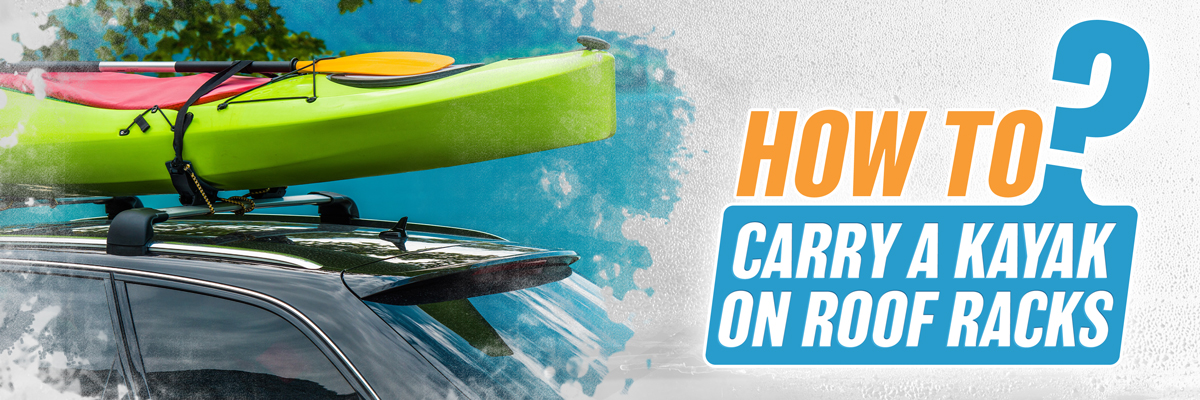How to Carry a Kayak on Roof Racks

When people first get a kayak, it’s because they’re thinking about effortlessly gliding through the water with nothing but the sounds of the paddles gently slapping the water. However, they may not consider how they're getting their new kayak to the water. When transporting a kayak or canoe, your best option is to strap it to the roof of your car. But, this can lead to many questions, including, how do you transport a kayak on a roof, and how do I put a kayak on top of my car?
This guide will cover the essentials about kayak carriers (which will also explain canoe carriers) and answer most of your questions. A quality roof rack designed to transport a kayak is a vital part of your kayak accessories kit and is usually the only way you can safely transport a kayak. A complete understanding of the different types available will give you a good idea of the best roof racks style for you.
Choose the best kayak roof rack for your vehicle.
When buying a roof rack specifically for a kayak or canoe, there are several different options available and your vehicle type may limit your choices. For example, the roof of your car has may not suit all types of roof racks. There are many answers for, what are the best roof racks for kayaks? It all depends on what type of kayak you’re carrying, what roof racks your vehicle can accommodate and if you’re carrying more than one kayak.
A good quality roof rack system will not only get your kayak to the water safely, but it’ll stop any damage to your vehicle and kayak. Your vehicle type and the mounting points may limit your options, so it is best to understand these before selecting your roof racks.
- Factory Crossbars - these are usually installed by the dealer when the car is purchased. These are designed specifically to suit your vehicle. While these are an excellent choice, there are additional accessories required to support your kayak.
- No Visible Anchor Points - if there are no obvious anchor points for a roof rack, you have a bare roof vehicle. However, there are still good options with roof racks suitable for kayaks.
- Rails - these are available in two different styles, raised and flush. The raised rails will have a gap between the roof and the rail, and a flush style will have no gap at all. These rails are designed for use with most hard rack systems.
- Gutters - these are not common in modern cars. Gutters have a similar appearance to roof gutters on your home, and they are cupped metal sections welded to your roof.
- Fixed Points - a plastic clip usually covers these, they are designed to be hidden during regular use, and roof racks can be installed into these and provide a sturdy and secure finish.
- Tracks - are channels that run the length of your vehicle, these are often factory installed, but you can purchase them in an aftermarket situation.
In addition to your chosen racks, there are several other accessories you’ll need for safe transport. You can include padding to help protect the roof of your vehicle, at least two tie-down straps, ropes (or additional tie-down straps) to use as bow and stern lines. If your kayak is longer than your vehicle, you may also require a safety flag to guide other drivers.
The different types of kayak roof racks
If you’re carrying one kayak and need space for other items, then the J style kayak carrier is designed to load a kayak on its side and this will save space allowing room for other items. You can load a second watercraft (e.g., surfboards) next to the kayak when using the J-style kayak carrier style. However, if your kayaks can be stacked due to their hull shape, you may only require soft or inflatable roof racks.
The specific hull shapes of your kayaks can determine which set of roof racks is best suited. You may also consider how you carry two kayaks on a car roof? Stackable kayaks can be placed onto most roof racks. Others may benefit from adding specific kayak cradles (such as the twin J-style carrier or the kayak or canoe holder) to provide additional support.
In this section, we’ll cover the different types of roof racks for kayaks, and you can determine which is best suited for your kayaks and your vehicle.
Hard Racks
Hard Racks (sometimes called mounted crossbars) are used for cars with side rails, gutters, and tracks or fixed points. The main downside of hard racks is they are not a universal fit, but you can generally find a set to suit your particular vehicle. You’ll find that the makers of hard rails (e.g. Rhino Rack) will have a list of suitable roof racks for your vehicle.
Soft Racks
Soft racks are ideal for any vehicle (including 4WDs) with raised rails, fixed points, tracks, or no anchor points. Many people may ask, are soft roof racks any good? While soft roof racks may seem like they're not up to the job, they are an excellent solution for many vehicles. These racks are easy to install and are considered the simplest solution to transporting a kayak as you can use them on most vehicles.
Soft racks are two tubes with a strap running down the middle. The straps are fed through the front and rear doors and secured in place. These racks are compact and lightweight, and they are swift to install. Soft racks can be inflatable, made from rubber, or other materials. They’ll help protect your vehicle and your kayak from any damage during transit.
Flexible Pads
Flexible pads are more of an accessory to your kayak rather than a set of roof racks. However, they are an essential part of any kayak transport system. If you have a set of factory crossbars or other hard racks, adding flexible pads can help to protect both your racks and your kayak (or boat). The Yakima Crossbar Pads (available in 20in or 30in) are suitable for most hard roof racks.
Getting assistance from a loading kayak carrier
With current kayak carrying technology, you can get assistance loading your kayaks onto roof racks. These devices will provide support and are ideal for anyone who is loading kayaks themselves or requires help in lifting heavy items. Loading and unloading a kayak is made easy by using these loaders and are brilliant for helping pack up after a few hours of kayaking.
When loading a kayak, you may be thinking, do you have to use bow and stern tie-downs for a kayak? These tie-downs should be used for kayaks as they provide additional stability. If you’re only travelling a short distance, then you may not need them.
Driving safe with your kayak on roof racks
Transporting kayaks safely is your main goal whenever you’re taking your kayak out for the day. If they are not appropriately secured to your roof racks, they may fall off and be damaged. It is advisable to stop every hour during longer trips and check that all your straps have remained tight.
FAQ about kayak roof racks
Loading kayaks onto roof racks
How do you tie down a kayak on a roof rack?
The best method for tying down a kayak is to use straps. Common straps used are tie down straps or ratchet straps. If you are concerned about the metal buckle damaging your car, there are straps with a silicon cover over the buckle to help prevent scratches. It is not advisable to use elastic straps (or bungee cords) as these are not secure, when using ratchet straps be mindful of over tightening as this will lead to hull damage.
How do you secure a kayak to a roof rack?
First, secure the middle of your kayak down with ratchet straps. Secondly, you should install the bowline to the bonnet of your vehicle. Finally, you can secure the stern line to the rear of your vehicle. Using quality straps, such as the Yakima bow/stern tie-down, is an excellent solution.
How do you put a kayak on a roof rack by yourself?
You can lift these by yourself for lightweight kayaks, but using a loading system is often easier. Investing in a kayak loading system (e.g., Yakima showdown kayak side loader) is ideal for loading a kayak yourself. For kayaks with a V-shaped hull, you can use the K-rack kayak loader for assistance.
How many kayaks fit on a roof rack?
With some kayak roof racks, you can carry up to 4 kayaks. You may be limited to two or three for most standard hard or soft roof racks. When you are carrying kayaks on your roof, you should measure the total height of your vehicle so you can avoid issues, such as low clearance bridges.
Do I need to secure the front and rear of the kayak to the car?
When securing a kayak the front and rear should be anchored to avoid rocking. Rocking can lead to damage to the kayak and the roof racks
General questions about transporting kayaks
How do I put a kayak on top of my car?
Loading a kayak is easiest with two people. You can lift the kayak to the correct height and then place it into the cradles or lay it flat on the crossbars. Makes sure you use straps in the middle and one each for the bow and stern.
Do you put a kayak upside down on a car?
If you have hard or soft roof racks, then it is advisable to place the kayak top side down. If your kayak is V-shaped, it may be better to purchase a kayak or canoe carrier holder and keep it upright.
Can you put a kayak on a car without a roof rack?
It is inadvisable to place a kayak on your car roof without some form of roof rack as it’ll cause damage to your car and your kayak. Soft roof racks are ideal for many vehicles and can be installed easily.
Are roof rack pads necessary?
Roof rack pads help to protect your kayak. While they may not be essential, they’ll help stop the roof racks from causing any damage to your kayak. For a small investment, we feel they’re well worth it.
Where to buy kayak roof racks near me?
At Kayaks2Fish, we have a large range of kayak racks that will suit almost any vehicle. When you load a kayak or canoe, you need the best equipment available to help you get it completed properly. Our team is highly experienced and will provide support in choosing the best kayak loading system or a space-saving design that will fit your capabilities and needs.
In our extensive range of kayak accessories, you’ll find all the gear and tools to make transporting your kayaks a breeze. With these systems, you’ll be happy to load up the kayak and get out paddling in your local area more often. You can shop in our store and have your order sent directly to your home, or you can collect these from any of our collection sites. If you need any assistance in choosing the right kayaking gear, please call our team for support.










